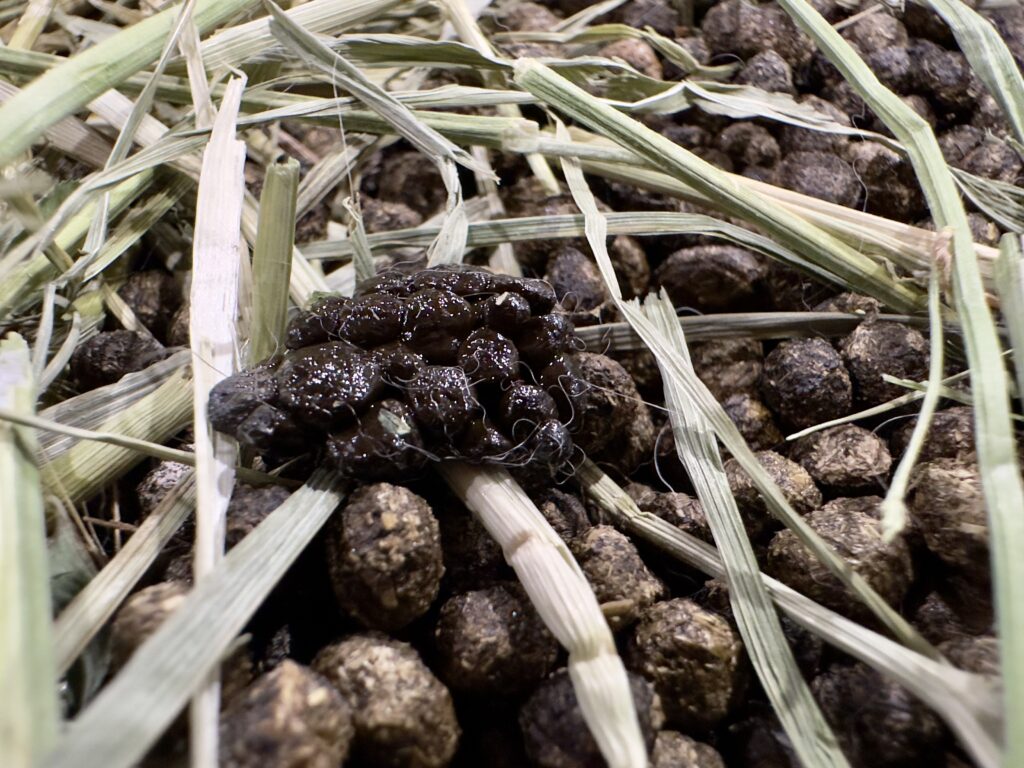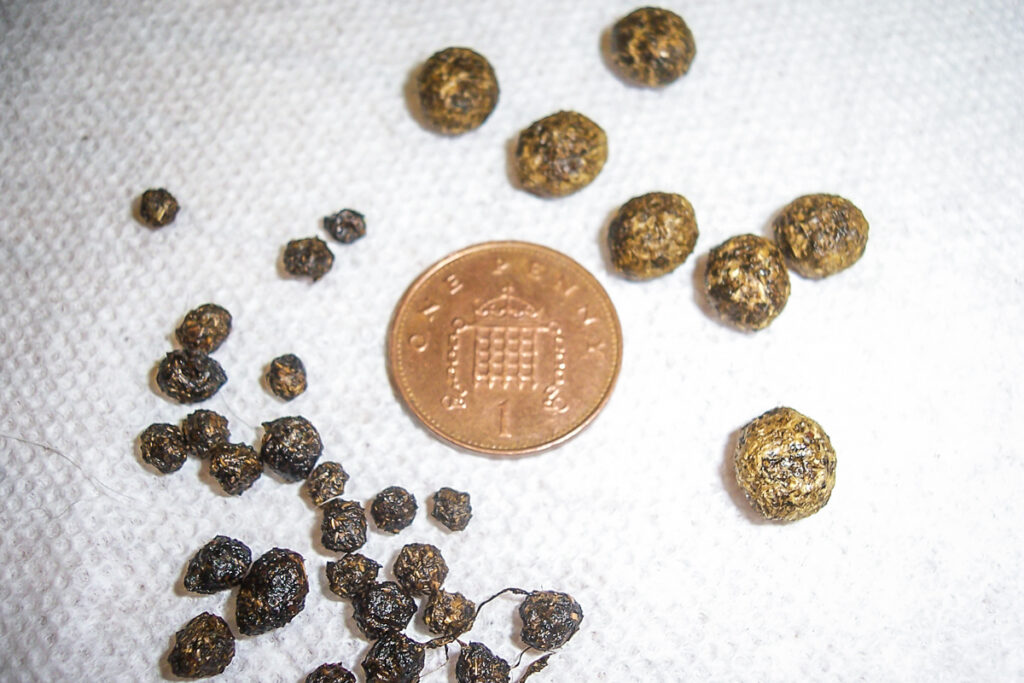If you have an infant or juvenile rabbit suffering from runny stool,
you should consider it a life-threatening emergency requiring immediate veterinary care.
Unlike most other mammals, lagomorphs (including domestic rabbits) produce two types of droppings, fecal pellets (the round, dry ones you usually see in the litterbox) and cecotropes. The latter are produced in a region of the rabbit’s digestive tract called the cecum, a blind-end pouch located at the junction of the small and large intestines. The cecum contains a natural community of bacteria and fungi that provide essential nutrients and may even protect the rabbit from potentially harmful pathogens.
How does the rabbit get those essential nutrients? She eats the cecotropes as they exit the anus. The rabbit’s blissful expression when she’s engaging in cecotrophy (the ingestion of cecotropes) will tell you that she finds this anything but disgusting. In fact, rabbits deprived of their cecotropes will eventually succumb to malnutrition. Cecotropes are not feces. They are nutrient-packed dietary items essential to your companion rabbit’s good health.
A rabbit may produce cecotropes at various times during the day, and this periodicity may vary from rabbit to rabbit. Some produce cecotropes in the late morning, some in the late afternoon, and some at night. In any case, they usually do this when you’re not watching (quite polite of them). This might be why some people refer to cecotropes as “night droppings,” though cecotropes are not always produced at night. A human face is apparently an excellent and refreshing palate-cleanser, as a favorite activity immediately post-cecotrophy often seems to be “kiss the caregiver”. Mmmmmm.
Normal Intestinal Products
Anyone who lives with a bunny has seen a fecal pellet. These are the small, brown “cocoa puffs” that (we hope) end up in the litterbox. They should be relatively spherical, somewhat dry and friable, and composed mostly of undigested fiber. Rabbits do not ordinarily re-ingest fecal pellets, though a few bunnies seem to enjoy an occasional fecal pellet hors d’ouevre with no harm.

A normal cecotrope resembles a dark brown mulberry, or tightly bunched grapes. It is composed of small, soft, shiny pellets, each coated with a layer of rubbery mucus, and pressed into an elongate mass. The cecotrope has a rather pungent odor, as it contains a large mass of beneficial cecal bacteria. When the bunny ingests the cecotrope, the mucus coat helps protect the bacteria as they pass through the stomach, then re-establish in the cecum.
Runny Stool: When Things Go Wrong
True diarrhea (unformed, watery feces) is relatively rare in adult rabbits. It can be caused by intestinal parasites, such as coccidia (Eimeria spp.), roundworms, tapeworms, or anything that inflames the intestinal lining. Your rabbit-experienced veterinarian will be able to examine a fecal sample (you should probably provide the vet with a fresh sample both fecal and cecal pellets, if possible) to examine them for signs of parasitic infection. More often, true diarrhea is seen in infant and juvenile rabbits.
Diarrhea in Baby Rabbits: A Life-Threatening Emergency
One of the most common signs associated with sudden death in baby rabbits is diarrhea, which can appear very quickly and kill in a matter of hours. Thus, it is of vital importance that any baby rabbit showing signs of lethargy, inappetence (not wanting to eat), or runny stool be taken immediately to an experienced rabbit veterinarian for emergency, life-saving treatment. Delaying even for an hour or two can mean the difference between life and death.
If you cannot find a rabbit-experienced veterinarian, but have an emergency clinic that is willing to accept help from unknown persons on the internet (that would be me), then please print this Emergency Treatment Protocol for Diarrhea in Infant Rabbits (pdf). This is a protocol I developed while trying to save wild baby cottontails and hares, and it is the only thing I have found that does save them. I hope no one reading this ever needs it…but it is here, just in case.
True diarrhea is more prevalent in baby rabbits than in adults, especially if the babies have been taken from their mother before they are ready for weaning. Sadly, many baby rabbits are weaned too young to be away from their mothers. Instead of being allowed to nurse for a full, normal eight weeks, they are taken away while they are still “cute” and marketable–often as young as four weeks. This can spell death for many of them.
Without mother’s antibodies, complex organic compounds and proper pH environment her milk provides to help protect the baby’s intestines, these babies are highly susceptible to over-proliferation of foreign bacteria. One of the most common culprits of runny stool in baby rabbits is accidental infection by the common human intestinal bacterium, Escherichia coli. This is transmitted from humans to baby rabbits during handling, since these bacteria are all over us, not just in our intestines. Handling an unweaned infant rabbit without properly washing and disinfecting one’s hands is a good way to transmit these opportunistic pathogens. Even a loving kiss on a too-young baby rabbit’s lips can kill. Until a young rabbit is at least eight weeks old, she should not be taken from her mother, as mama’s milk affords protection against E. coli and other bacteria until the baby’s own immune system can handle them.
Another pathogen that can cause diarrhea in baby rabbits is Eimeria spp., the causative agent of coccidiosis. The reproductive sporocysts of these protist parasites can usually be seen in the feces of the host, so your vet may wish to examine the fecal sample of the affected rabbit for signs of coccidial sporocysts.
Unformed Cecotropes: Mushy or Runny Stool
Perhaps the most common complaint regarding rabbit health is the problem of mushy or runny stool sticking to the bunny’s anal area and creating a nasty, stinky mess. In most cases (in adult rabbits, at least), this mass is made of poorly formed cecotropes that have the consistency of toothpaste, rather than the normal form of bunched, squishy pellets.
The cecum is a delicately balanced ecosystem. If the intestine is moving too slowly, or if the rabbit is getting a diet too rich in digestible carbohydrates and too low in crude fiber, the complex population of bacteria in the cecum can become “unbalanced.” This condition is known as cecal dysbiosis. Cecal dysbiosis means that the beneficial bacteria (e.g., Bacteroides spp. and a variety of others, including archaeans) are outcompeted and outnumbered by less desirable inhabitants such as yeast (a fungus, usually Saccharomycopsis sp.) or even very harmful bacteria such as Clostridium spp., related to the ones that cause tetanus and botulism.
A rabbit suffering from cecal dysbiosis will produce cecotropes that are mushy, pasty or even liquid. They are usually quite foul-smelling, and often stick to the bunny’s back end in great, nasty clumps. These unformed cecotropes are not a primary disease, however. They are a symptom of a disorder somewhere in the bunny’s system. In order to solve the runny stool problem, the underlying cause must be addressed.
Common Causes of Runny Stool in Infant and Juvenile Rabbits
Weaning Too Young
If the bunny suffering from runny stool is a baby, how old is he? If younger than eight weeks, and no longer with his mother, his runny stool problem may be due to his being weaned too young. Many pet stores will (illegally) sell rabbits younger than eight weeks of age (some as young as four weeks), because that is when they are still “cute” and more apt to be purchased on a whim. Sadly, many of these babies are doomed to succumb to intestinal disorders.
Unlike most mammals, baby rabbits have a sterile lower intestine until they begin to eat solid food at the age of 3-4 weeks. It is during this time that their intestines are at their most vulnerable: the babies need their mother’s milk, which changes pH and provides vital antibodies that help the baby gradually adjust to his changing intestinal environment, to protect them against newly introduced microorganisms. Without mother’s milk, a baby starting to eat solid food is highly susceptible to bacterial enteritis (inflammation of the intestinal lining), which can cause fatal diarrhea. Runny stool in a baby rabbit should be considered a life-threatening emergency, and anyone seeing this should contact a rabbit-savvy veterinarian immediately, and consult the Emergency Treatment Protocol for Diarrhea in Infant and Juvenile Rabbits to be well-informed about questions to ask the vet.
Intestinal Parasites
As mentioned before, coccidial infection is common in some areas, and some vets will simply treat a baby rabbit’s diarrhea as coccidia, even without a fecal test. Common antibiotics used to treat coccidia include Albon (sulfadimethoxine) and the potentiated sulfas, such as Trimethoprim Sulfa (TMZ) or Bactrim. However, we have found a more recently developed drug, ponazuril to be far superior to the aforementioned sulfa antibiotics. It eliminates the parasites in a matter of days, rather than weeks.
Common Causes of Runny Stool in Adult Rabbit
Mechanical Problems
Obesity
An overweight rabbit may produce normally formed cecotropes, but because she cannot properly reach down to grab them as they emerge from the chute, these soft pellets can becom squashed under the bunny as she flexes and bends around to get them. Weight reduction is the answer here, and this is as difficult for rabbits as it is for humans. Eliminating commercial pellets, or at least switching to a high-fiber, low-calorie timothy-based pellet can make a great difference. Replace any starchy treats with fresh herb treats. And, painful as it may be, exercise is one of the best ways to burn more calories than bunny takes in. As we all should know, that’s the bottom line when it comes to slimming down.
Arthritis or Other Skeletal Disorders
Similarly, a rabbit who is suffering from degenerative joint problems in the spine, hips, or other areas, may not be able to reach cecotropes easily. He ends up sitting on some of them, and squashing them into his fur. Arthritis can be treated by your veterinarian. Common remedies include various NSAIDs (Non-Steroidal Anti-inflammatory Drugs), and glucosamine supplements such as Cetyl-M or myristol.
Dietary Problems
Incorrect Diet
Rabbits, like horses and cattle, are strict herbivores. The rabbit intestine–and its normal bacterial flora–has evolved to feed almost exclusively on grass and herbs. >br> Does your rabbit get starchy treats such as oatmeal, crackers, bread or sweets? Some rabbits with very sensitive intestines can suffer from runny cecotropes even from commercial pellets. Fruit, as healthy as it is for humans, can be too much of a good thing for rabbits. The high level of sugar and starch in table fruit makes them too rich for a bunny except as a very small, occasional treat. A diet too rich in digestible starch is one of the most common causes of runny cecotropes in companion rabbits.
Insufficient Indigestible Fiber
A rabbit should be fed unlimited grass hay, such as timothy, brome, wheat or oat. Alfalfa hay is too rich in calories and protein for daily feeding. A rabbit who cannot nibble constantly on high-fiber grass or hay may suffer from a lack of tonus in the gut muscles. Normal peristalsis (muscular movements that push food through the gut) may become sluggish. This causes the passage of food through the cecum to slow down, and the normal rate of bacterial “flushing” from the cecum is disrupted, promoting cecal dysbiosis. The high fiber content of grass hay also helps to “dilute” the starch of other dietary items, and helps to provide a healthy intestinal environment. A complete and healthy diet is truly key to preventing intestinal problems such as cecal dysbiosis (and its associated mushy stool).
Hidden Health Problems
When a rabbit is ill, in pain, or is suffering from emotional stress, a typical physiological response is slowing of the normal peristaltic movements of the intestine. This results in cecal dysbiosis, with all the accompanying problems of runny stool, and possible inflammation of the intestinal lining (enteritis).Some of the most common causes of intestinal slowdown (and hence, cecal dysbiosis) in rabbits include pain/stress due to
Any of these conditions must be diagnosed and treated by a rabbit-savvy veterinarian familiar with such problems and their appropriate treatment. Until a cryptic health disorder is diagnosed and treated, chronic runny stool will likely persist. Therefore, it’s wise to have your messy-bottomed bunny undergo a thorough wellness check, especially if his diet and weight are normal and healthy.Once an underlying source of pain/stress is treated, the runny stool often resolves on its own. But if the condition is not treated, it can progress and eventually result in a potentially life-threatening condition, ileus, or GI stasis, in which peristalsis stops completely.
Keeping Bunny Comfortable in the Meantime
While you and your veterinarian are treating the problems that caused the runny stool, it’s still important to keep the bunny clean and comfortable. Dried cecotropes stuck to the rear end are not only smelly and uncomfortable, they also attract flies, and can result in life-threatening fly strike.To prevent this, be sure to learn how to give your bunny a butt bath—SAFELY.
Resolving runny stool in a rabbit is not always a simple matter. It may require dietary changes, good husbandry, and sometimes extensive diagnostic work and treatment by your veterinarian. But it will all be worth it for a long life filled with happy, nose-wiggling love and a nice, clean bum.

